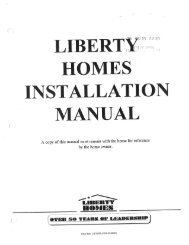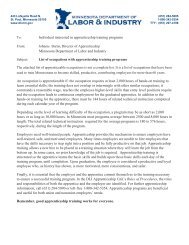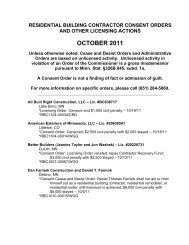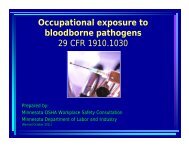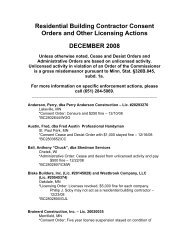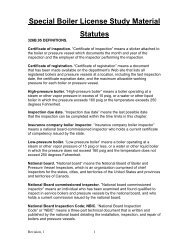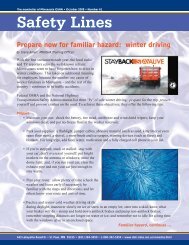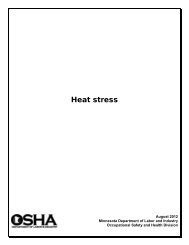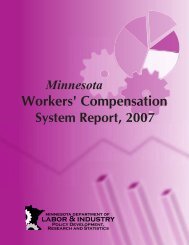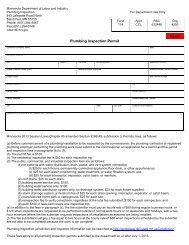Emergency eyewash and showers - Minnesota Department of Labor ...
Emergency eyewash and showers - Minnesota Department of Labor ...
Emergency eyewash and showers - Minnesota Department of Labor ...
Create successful ePaper yourself
Turn your PDF publications into a flip-book with our unique Google optimized e-Paper software.
<strong>Emergency</strong><br />
<strong>eyewash</strong> <strong>and</strong> <strong>showers</strong><br />
<strong>Emergency</strong> <strong>eyewash</strong><br />
<strong>Emergency</strong><br />
shower<br />
Prepared by:<br />
MNOSHA Workplace Safety Consultation<br />
<strong>Minnesota</strong> <strong>Department</strong> <strong>of</strong> <strong>Labor</strong> <strong>and</strong> Industry<br />
June 2011
When does OSHA require an<br />
emergency <strong>eyewash</strong> <strong>and</strong>/or<br />
shower?<br />
For general industry worksites,<br />
29 CFR 1910.151(c) states:<br />
“Where the eyes or body <strong>of</strong> any person may be<br />
exposed to injurious corrosive materials, suitable<br />
facilities for quick drenching or flushing <strong>of</strong> the eyes<br />
<strong>and</strong> body shall be provided within the work area for<br />
immediate emergency use.”
When does OSHA require an<br />
emergency <strong>eyewash</strong> <strong>and</strong>/or<br />
shower?<br />
29 CFR 1910.151 applies in all general<br />
industry situations unless a vertical<br />
st<strong>and</strong>ard applies to a specific hazard.<br />
Examples include:<br />
• 29 CFR 1910.124(g)(2) – dipping <strong>and</strong> coating<br />
• 29 CFR 1910.261(b)(2) – pulp, paper <strong>and</strong><br />
paperboard mills<br />
• 29 CFR 1910.268(g)(18) – telecommunications<br />
• 29 CFR 1910.1048(i) – formaldehyde<br />
• 29 CFR 1910.1052(i) – methylene chloride
When does OSHA require an<br />
emergency <strong>eyewash</strong> <strong>and</strong>/or<br />
shower?<br />
For construction worksites,<br />
29 CFR 1926.50(g) states:<br />
“Where the eyes or body <strong>of</strong> any person may be exposed<br />
to injurious corrosive materials, suitable facilities for<br />
quick drenching or flushing <strong>of</strong> the eyes <strong>and</strong> body shall<br />
be provided within the work area for immediate<br />
emergency use.”
When does OSHA require an<br />
emergency <strong>eyewash</strong> <strong>and</strong>/or<br />
shower?<br />
29 CFR 1926.50(g) applies in all<br />
construction situations, except battery<br />
h<strong>and</strong>ling is addressed in 29 CFR<br />
1926.441(a)(6), which states:<br />
“Facilities for quick drenching <strong>of</strong> the eyes <strong>and</strong><br />
body shall be provided within 25 feet (7.62<br />
meters) <strong>of</strong> battery h<strong>and</strong>ling areas.”
What materials require an<br />
<strong>eyewash</strong> <strong>and</strong>/or <strong>eyewash</strong> <strong>and</strong><br />
shower?<br />
Materials that can cause damage to the eyes<br />
or skin, or materials that are readily<br />
absorbed through the skin. They can be in<br />
the following forms:<br />
• liquids (most common);<br />
• solids;<br />
• gases;<br />
• vapors; <strong>and</strong><br />
• mists.
Methods to determine if a material<br />
can damage the eye <strong>and</strong> skin or<br />
can be absorbed through the skin<br />
• Consult the “Health hazard”<br />
section <strong>of</strong> the manufacturer’s<br />
material safety data sheet<br />
(MSDS).<br />
– Indications <strong>of</strong> irritation may<br />
not require <strong>eyewash</strong> or<br />
shower.<br />
– Indications <strong>of</strong> burns, corneal<br />
damage, blindness or eye<br />
damage will confirm the<br />
need for an emergency<br />
<strong>eyewash</strong> <strong>and</strong>/or shower if a<br />
potential for employee<br />
exposure exists.<br />
• Directly consult with the manufacturer <strong>of</strong> the material.
Methods to determine if a material<br />
can damage the eye <strong>and</strong> skin or<br />
can be absorbed through the skin<br />
• Consult the NIOSH “Pocket guide to chemical<br />
hazards” (NIOSH publication no. 2005-149, available at<br />
www.cdc.gov/NIOSH.<br />
– If it states “Provide:<br />
<strong>eyewash</strong> <strong>and</strong>/or quick<br />
drench,” an emergency<br />
<strong>eyewash</strong> <strong>and</strong>/or shower<br />
will be needed if a<br />
potential for employee<br />
exposure exists.
Methods to determine if a material<br />
can damage the eye <strong>and</strong> skin or<br />
can be absorbed through the skin<br />
• For liquids, determine the pH <strong>of</strong> the solution (an<br />
indication <strong>of</strong> acidity or alkalinity).<br />
pH = - log 10 (H + )<br />
pH is a measure <strong>of</strong> the concentration <strong>of</strong> hydrogen<br />
ions in a liquid solution.
The pH scale<br />
0 1 2 3 4 5 6 7 8 9 10 11 12 13 14<br />
Acidic<br />
Neutral Alkaline<br />
Effect <strong>of</strong> dilution: Because <strong>of</strong> the logarithmic nature <strong>of</strong> the pH scale,<br />
a 10-fold dilution with water changes the pH by 1.<br />
For example, if beginning with a solution with a pH <strong>of</strong> 14:<br />
– a dilution <strong>of</strong> 1 : 10 results in a pH <strong>of</strong> 13 (pH change <strong>of</strong> 1);<br />
– a dilution <strong>of</strong> 1 : 100 results in a pH <strong>of</strong> 12 (pH change <strong>of</strong> 2);<br />
– a dilution <strong>of</strong> 1 : 1,000 results in a pH <strong>of</strong> 11 (pH change <strong>of</strong> 3);<br />
– a dilution <strong>of</strong> 1 : 10,000 results in a pH <strong>of</strong> 10 (pH change <strong>of</strong> 4); <strong>and</strong><br />
– a dilution <strong>of</strong> 1 : 100,000 results in a pH <strong>of</strong> 9 (pH change <strong>of</strong> 5).
At what pH levels does MNOSHA<br />
require an emergency <strong>eyewash</strong>?<br />
0 1 2 3 4 5 6 7 8 9 10 11 12 13 14<br />
Whenever an employee works with a chemical with a pH <strong>of</strong> 2 or<br />
less (very acidic) or a pH <strong>of</strong> 11 or greater (very basic or alkaline)<br />
<strong>and</strong> the manner in which the employee works with the material<br />
poses a potential for a splash or spatter to the eyes <strong>and</strong> face, an<br />
ANSI-approved emergency <strong>eyewash</strong> must be provided for access<br />
within 10 seconds <strong>of</strong> the hazard area.<br />
Note: In the situation above, the employer would also have to<br />
provide – <strong>and</strong> require the use <strong>of</strong> – adequate eye <strong>and</strong> face<br />
protection (chemical splash goggles <strong>and</strong> a chin-length wraparound<br />
face shield). The use <strong>of</strong> such personal protective<br />
equipment does not change the need for an emergency <strong>eyewash</strong>.
At what pH levels does MNOSHA<br />
also require an emergency shower?<br />
0 1 2 3 4 5 6 7 8 9 10 11 12 13 14<br />
Whenever an employee works with a chemical with a pH <strong>of</strong> 1 or<br />
less (highly acidic) or a pH <strong>of</strong> 12 or greater (highly basic or<br />
alkaline) <strong>and</strong> the manner in which the employee works with the<br />
material poses a potential for contact with the skin <strong>of</strong> the body,<br />
an ANSI-approved emergency shower must also be provided for<br />
access within 10 seconds <strong>of</strong> the hazard area.<br />
Note: In the situation above, the employer would also have to<br />
provide – <strong>and</strong> require the use <strong>of</strong> – adequate skin protection<br />
(gloves, splash aprons, boots, etc). The use <strong>of</strong> such personal<br />
protective equipment does not change the need for an emergency<br />
shower.
How does a material cause a<br />
chemical burn?<br />
Chemical burns usually<br />
do not involve the the<br />
same destruction mechanism<br />
as thermal burns.<br />
They can destroy skin <strong>and</strong> Protein coagulation in the eye<br />
tissues by coagulating proteins. caused by contact with a<br />
highly alkaline liquid
How does a material cause a<br />
chemical burn?<br />
Oxidation, reduction, corrosion<br />
<strong>and</strong> desiccation are a few <strong>of</strong> the<br />
chemical reactions responsible<br />
for the tissue damage occurring<br />
in a chemical burn.<br />
The foreign substance causing<br />
the burn has disrupted the<br />
delicate biochemistry <strong>of</strong> the<br />
tissues, resulting in the tissue<br />
destruction.
What is considered an adequate<br />
<strong>eyewash</strong> <strong>and</strong> shower?<br />
MNOSHA uses ANSI Z358.1-2009 as a guide<br />
for the construction, installation <strong>and</strong> use <strong>of</strong><br />
emergency <strong>eyewash</strong> <strong>and</strong> shower equipment.
ANSI Z358.1-2009<br />
Requirements that apply to both<br />
<strong>eyewash</strong> units <strong>and</strong> shower units<br />
• The sole purpose must be as<br />
an <strong>eyewash</strong> or emergency<br />
shower unit.<br />
• If a shower is needed, a<br />
separate <strong>eyewash</strong> is<br />
required; a combination unit<br />
is also acceptable.
ANSI Z358.1-2009<br />
Requirements that apply to both<br />
<strong>eyewash</strong> units <strong>and</strong> shower units<br />
• The unit must be<br />
equipped with a quickopening<br />
valve that<br />
remains open when<br />
activated. It must be<br />
simple to operate in a<br />
time <strong>of</strong> one second<br />
or less.<br />
• Once activated, both<br />
h<strong>and</strong>s must be kept<br />
free to hold open the<br />
eyelids to facilitate<br />
flushing.
ANSI Z358.1-2009<br />
Requirements that apply to both<br />
<strong>eyewash</strong> units <strong>and</strong> shower units<br />
• The water temperature must be tepid or<br />
lukewarm (between 60 0 F <strong>and</strong> 100 0 F or<br />
between 15 0 C <strong>and</strong> 38 0 C).<br />
– For emergency <strong>eyewash</strong> units, this temperature<br />
range will ensure the eyes <strong>and</strong> face can be held in the<br />
flushing water for 15 minutes, the amount <strong>of</strong> time<br />
required to adequately flush the eyes.<br />
– For emergency shower units, this temperature<br />
range will minimize the likelihood <strong>of</strong> inducing shock.<br />
– These temperatures can be achieved through the<br />
installation <strong>of</strong> a mixing valve on hot <strong>and</strong> cold water<br />
lines.
ANSI Z358.1-2009<br />
Requirements that apply to both<br />
<strong>eyewash</strong> units <strong>and</strong> shower units<br />
• Travel-time between the operation where<br />
the hazardous substance is used <strong>and</strong> the<br />
unit, must be 10 seconds or fewer.<br />
– Appendix B5 <strong>of</strong> ANSI Z358.1-2009 states an<br />
average person covers a distance <strong>of</strong> approximately<br />
55 feet in 10 seconds, when walking at a normal<br />
pace.<br />
– The unit must be on the same level as the<br />
operation in question. The climbing <strong>of</strong> stairs to<br />
reach the unit during an emergency is not allowed.
ANSI Z358.1-2009<br />
Requirements that apply to both<br />
<strong>eyewash</strong> units <strong>and</strong> shower units<br />
• Travel-time issues (continued):<br />
– ANSI recommends the unit be immediately adjacent to<br />
the hazard when the pH <strong>of</strong> the hazardous substance<br />
is less than or equal to 1, or equal to or greater than<br />
12.<br />
Note: When strong acids or strong alkaline materials<br />
make contact with the eyes, the damage occurs<br />
within 15 seconds. If it takes more than 10 seconds<br />
to reach the unit, it may not be effective in minimizing<br />
the likelihood <strong>of</strong> tissue damage.
ANSI Z358.1-2009 Requirements<br />
that apply to both <strong>eyewash</strong> units<br />
<strong>and</strong> shower units<br />
• The location <strong>of</strong> the<br />
unit must be well<br />
lit, highly visible<br />
<strong>and</strong> marked with a<br />
highly visible sign.
ANSI Z358.1-2009 Requirements<br />
that apply to both <strong>eyewash</strong> units<br />
<strong>and</strong> shower units<br />
• The unit must be operable at all times, with<br />
provisions to prevent unauthorized shut<strong>of</strong>f<br />
<strong>of</strong> the water lines to the unit.<br />
• A sewer connection or drain is not<br />
required, unless a special hazard is posed<br />
by water.<br />
• Units shall be installed in accordance with<br />
the manufacturer’s instructions.
ANSI Z358.1-2009<br />
Requirements that apply only to<br />
<strong>eyewash</strong> units<br />
• Eyewash units must be<br />
installed so that nozzles<br />
are 33 to 45 inches (83.8<br />
to 114.3 cm) from the<br />
floor.<br />
• Eyewash units must be a<br />
minimum <strong>of</strong> six inches<br />
away from the nearest<br />
wall or obstruction.
ANSI Z358.1-2009<br />
Requirements that apply only to<br />
<strong>eyewash</strong> units<br />
• Eyewash units must<br />
provide a minimum <strong>of</strong><br />
0.4 gallons (1.5 liters)<br />
a minute <strong>of</strong> a potable<br />
water or commercial<br />
flush for 15 minutes.<br />
• Eyewash units must provide<br />
a pressure-reduced divergent flow <strong>of</strong> flushing fluid.
ANSI Z358.1-2009<br />
Requirements that apply only to<br />
<strong>eyewash</strong> units<br />
• Plumbed <strong>eyewash</strong> units must be flushed weekly<br />
to remove any sediment <strong>and</strong> microbial<br />
contamination.<br />
• The duration <strong>of</strong> the test is dependant on the<br />
volume <strong>of</strong> water contained in the unit itself <strong>and</strong><br />
all sections <strong>of</strong> pipework that do not form part <strong>of</strong><br />
a constant circulation system (also known as a<br />
dead leg).<br />
• The test should be long enough to clear the<br />
potentially stagnant water out <strong>of</strong> the dead leg.
ANSI Z358.1-2009<br />
Requirements that apply only to<br />
<strong>eyewash</strong> units<br />
• Where contamination<br />
can occur, nozzles must<br />
be protected from<br />
contaminants by covers<br />
(or caps) that do not<br />
require an extra step for<br />
removal beyond the<br />
activation <strong>of</strong> the unit.<br />
Eyewash cover<br />
Nozzle caps
ANSI Z358.1-2009<br />
Requirements that apply only to<br />
<strong>eyewash</strong> units<br />
• Self-contained <strong>and</strong><br />
portable <strong>eyewash</strong> units<br />
must provide 0.4<br />
gallons a minute (1.5<br />
liters a minute) for 15<br />
minutes (six-gallon<br />
capacity).<br />
• Portable <strong>eyewash</strong> units<br />
should be used only<br />
where fixed installation<br />
is not feasible.
ANSI Z358.1-2009<br />
Requirements that apply only to<br />
<strong>eyewash</strong> units<br />
• In self-contained <strong>and</strong> portable<br />
<strong>eyewash</strong> units, the flushing<br />
fluid must be replaced after<br />
any use.<br />
In addition, the fluid must be<br />
replaced at the intervals<br />
recommended by the<br />
manufacturer.
ANSI Z358.1-2009<br />
Requirements that apply only to<br />
<strong>eyewash</strong> units<br />
• Squeeze bottles are not acceptable <strong>eyewash</strong> units on<br />
their own. They cannot supply the required amount <strong>of</strong><br />
water to adequately flush the eyes <strong>and</strong> their use does<br />
not keep both h<strong>and</strong>s free to hold the eyelids open.<br />
• They can only be used as an interim<br />
protective measure, in conjunction<br />
with an approved <strong>eyewash</strong> facility,<br />
where installation difficulties are<br />
an issue.
ANSI Z358.1-2009<br />
Requirements that apply only to<br />
<strong>eyewash</strong> units<br />
• In the General Requirements for Dipping <strong>and</strong><br />
Coating Operations st<strong>and</strong>ard – 29 CFR<br />
1910.124(g)(2), drench hoses are allowed in<br />
lieu <strong>of</strong> a <strong>eyewash</strong> <strong>and</strong> shower at<br />
open-surface tanks containing<br />
hazardous liquids.<br />
The device must supply clean<br />
water provided by a ¾-inch diameter, 48-inch or<br />
longer hose with a quick-opening valve.<br />
Pressure should not exceed 25 psi.
ANSI Z358.1-2009<br />
Requirements that apply only to<br />
<strong>eyewash</strong> units<br />
• Many faucet-mounted <strong>eyewash</strong> devices do not meet<br />
ANSI construction requirements.<br />
• If use is planned, an ANSI-approved faucet-mounted<br />
<strong>eyewash</strong> must meet all requirements for plumbed<br />
<strong>eyewash</strong> units. This includes requirements for<br />
installation height, water<br />
temperature, unobstructed access,<br />
travel time, labeling, etc. Because <strong>of</strong><br />
the need for immediate use, the<br />
water temperature at the sink must<br />
immediately meet temperature<br />
requirements at all times.
ANSI Z358.1-2009<br />
Requirements that apply only to<br />
shower units<br />
• Showers must provide a minimum 20 gallons a minute<br />
(75.7 liters a minute) flow <strong>of</strong> flushing fluid in a<br />
dispersed pattern.<br />
• Weekly checks <strong>of</strong> the shower must be conducted to<br />
flush the lines <strong>and</strong> to verify proper operation.
ANSI Z358.1-2009<br />
Requirements that apply only to<br />
shower units<br />
• Overhead <strong>showers</strong><br />
should be mounted at a<br />
head height <strong>of</strong> 82 to 96<br />
inches (208.3 to 243.8<br />
cm) from the floor or<br />
platform.<br />
<strong>Emergency</strong><br />
shower
ANSI Z358.1-2009 Requirements<br />
that apply only to shower units<br />
• The valve actuator<br />
must not be located<br />
more than 69 inches<br />
(173.3 cm.) above the<br />
level on which the user<br />
st<strong>and</strong>s.<br />
<strong>Emergency</strong><br />
shower
ANSI Z358.1-2009<br />
Training requirements for<br />
emergency <strong>eyewash</strong> <strong>and</strong> shower<br />
• Employee are to be<br />
trained about the<br />
location <strong>and</strong> proper use<br />
<strong>of</strong> emergency<br />
<strong>eyewash</strong>es <strong>and</strong><br />
<strong>showers</strong>.<br />
<strong>Emergency</strong><br />
<strong>eyewash</strong>es <strong>and</strong> <strong>showers</strong>
ANSI Z358.1-2009<br />
Training requirements for<br />
emergency <strong>eyewash</strong> <strong>and</strong> shower<br />
• The training must<br />
address the holding<br />
open <strong>of</strong> the eyelids <strong>and</strong><br />
the rolling <strong>of</strong> the<br />
eyeballs to facilitate<br />
the flushing <strong>of</strong> the<br />
entire surface <strong>of</strong> the<br />
eye.
ANSI Z358.1-2009<br />
Training requirements for<br />
emergency <strong>eyewash</strong> <strong>and</strong> shower<br />
• If squeeze bottles are<br />
provided for use as an<br />
interim protective<br />
measure, the training<br />
must address proper use<br />
in conjunction with the<br />
provided emergency<br />
<strong>eyewash</strong>.
Questions?
Thank you!



